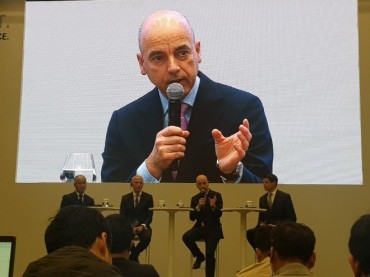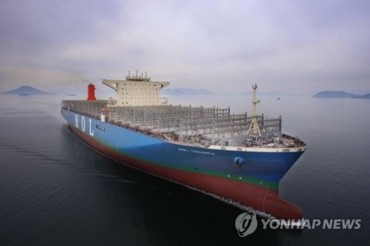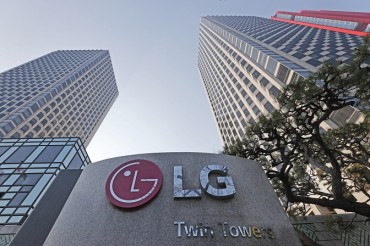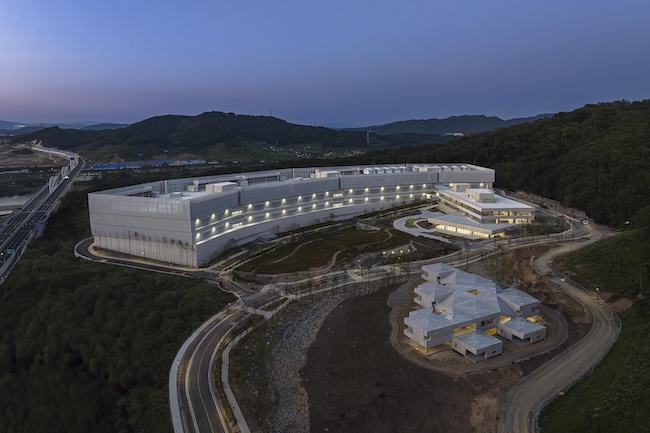
This photo shows Gak Sejong, Naver Corp.’s new data center in Sejong, 113 kilometers south of Seoul, as provided by the company. (Image courtesy of Yonhap)
SEJONG, Nov. 9 (Korea Bizwire) — Tripitaka Koreana, the most complete collection of Buddhist scriptures carved on around 80,000 wooden printing blocks made in the 13th century, has been preserved at a depository named Janggyeong Panjeon at Haein Temple in the southeastern county of Hapcheon in South Korea.
The storage hall, solely designed and built to house the wooden blocks with a natural control system that maintains suitable humidity and temperature in the 15th century, has survived several serious fires and even a near-bombing during the 1950-53 Korean War for nearly six centuries.
South Korean tech giant Naver Corp.’s new data center, Gak Sejong, has inherited the values of the historical building and embodied the company’s mission to pass on data to future generations for good as Janggyeong Panjeon, which is also called Janggyeong Gak, did.
“It functioned as a data center comprised of innovative technologies of the time,” Naver CEO Choi Soo-yeon said during a press tour of the center on Monday. “Gak was named after Jaggyeong Gak, which has preserved Tripitaka Koreana for centuries, and it means we will continue the values of the repository in modern times.”
Gak is a suffix given to a building in a royal palace or a storage room for valuables, including books.
Opened Monday and built on a 294,000 square meter-plot of land, Gak Sejong is the biggest data center owned by a single company in South Korea, and one of the biggest in Asia, according to Naver, the operator of South Korea’s most popular online portal of the same name.

This photo shows a server room at Naver Corp.’s new data center in Sejong, 113 kilometers south of Seoul, as provided by the company on Nov. 8, 2023. (Image courtesy of Yonhap)
It can store up to 600,000 units of servers which can harness 65 exabytes of data, and offer business-to-business and business-to-customer services in South Korea and also to other places near the country.
The company, whose business ranges from shopping, webtoons and K-pop content creation, has poured all of its architectural, technological and operational experiences and capacity into the new center to provide a hyperscale infrastructure for developing technologies, such as robotics, cloud and artificial intelligence.
One of Gak Sejong’s most notable features is a hybrid cooling system, which utilizes natural wind from the area to reduce electricity consumption and preserve the digital servers undamaged for a long period of time, as the centuries-old Janggyeong Panjeon did.
The air solution maximizes energy efficiency for the data center, one of the most energy-intensive building types, reducing 73 percent of its energy consumption compared with an ordinary cooling system.
Also, Gak Sejong focuses on safety and stability measures to effectively respond to natural disasters and other incidents, such as fire.
Based on the know-how of having kept its first data center, Gak Chuncheon, intact for 10 years, Naver installed a preparedness system to maintain service continuity in its new storage facility in the event of a disaster. It was also designed to withstand a 9.0 magnitude earthquake.
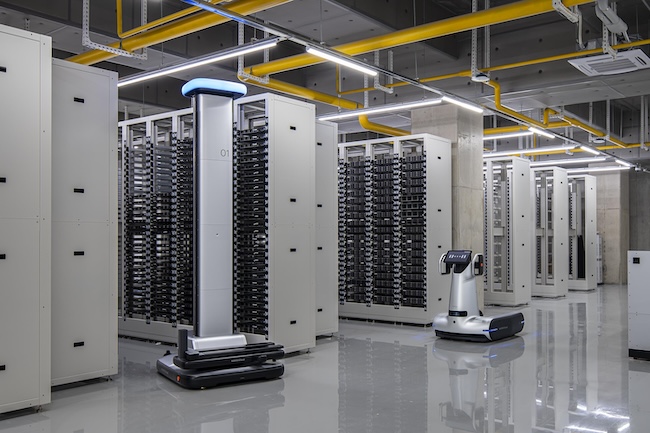
This photo, provided by Naver Corp., shows Sero (L) and Garo, a forklift robot and a server managing robot developed by Naver Labs Corp. to work at the company’s new data center in Sejong, 113 kilometers south of Seoul. (Image courtesy of Yonhap)
“Electricity supply is the heart of a data center,” Roh Sang-min, head of Naver’s Cloud Data Center, said. “Gak Sejong is operated under a system where power can be supplied for 72 hours in case there is a power disruption from a blackout or other reasons.”
The company seems to be mindful of a fire at Kakao Corp.’s data center in Pangyo, just south of Seoul, last year, which led to a massive service disruption nationwide in its mobile messenger KakaoTalk and other related services.
Naver’s state-of-the-art robotics technologies are also featured in the new digital repository, presenting a self-driving shuttle bus and automated robots, with an AI-Robot-Cloud-based multi-robot intelligence system and an adaptive robot management system.
Forklift robot Garo, which means horizontal in Korean, moves horizontally through large buildings, while Sero, named after the Korean word which means vertical, is a server managing robot that moves vertically to store things on the shelves in server rooms or warehouses.
The company, the first local IT company that got approval from the government to test-drive autonomous cars in 2017, said Gak Sejong is the first data center in South Korea to have working robots on site, which help improve efficiency in operation and reduce human errors.

Naver Corp. CEO Choi Soo-yeon speaks at a press tour of its new data center, Gak Sejong, in this photo provided by the company on Nov. 8, 2023. (Image courtesy of Yonhap)
“With the robots, there is no involvement from human beings, and this makes the process much simpler and less vulnerable to human errors, while integrating all of the assets into one system,” Myung Hyo-shin, the project manager of Naver Labs’ robotics and autonomous driving team, said, showcasing the interaction of Garo and Sero.
On top of that, Naver said Gak Sejong is playing a role in spearheading the company’s industry-leading artificial intelligence (AI) technology in its ambition to grow the center as the “engine of South Korea’s digital industry” in the near future.
Naver’s hyperscale AI service HyperCLOVA X is being trained at the Sejong center as it has a stable network of bandwidth of up to 800 gigabytes per rack, maximum power capacity of 270 megawatts and a power density of 20 kilowatts per rack.
Launched in August, HyperCLOVA X is a large language model tailored for the Korean language and a backbone model of its AI technology in a bid to win an intensifying global battle in the generative AI market.
“Gak Sejong is characterized by the close convergence of technologies, such as robotics and AI infrastructure operations, to meet the demands of managing vast sites and high-end servers,” said Choi, Naver’s chief. “We will move forward with bigger responsibilities to make the center the 21st century version of Janggyeong Gak.”
(Yonhap)



